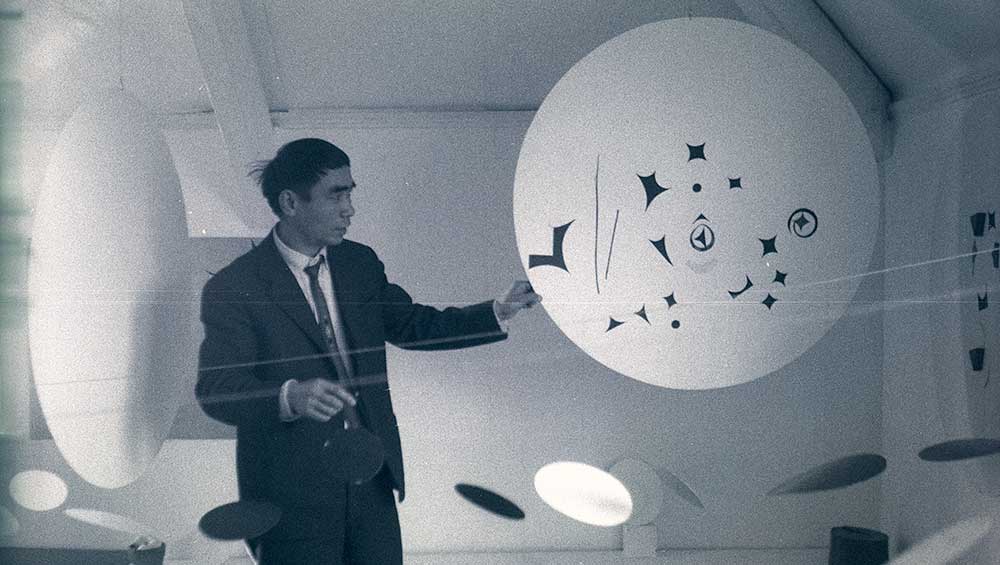
Li Yuan-chia in his studio at the LYC Museum and Art Gallery, Brampton, Cumbria, 1969. Image courtesy of Demarco Digital Archive University of Dundee & Richard Demarco Archive.
Kettle’s Yard, Cambridge
11 November 2023 – 18 February 2024
by BETH WILLIAMSON
You might wonder why an exhibition devoted to the work and ethos of the artist, poet and arts organiser Li Yuan-chia (1929-94) opens with Winifred Nicholson’s 1926 painting Roman Road (Landscape with Two Houses). Well, the road depicted is, coincidentally, the road that would later lead to Li’s LYC Museum and Art Gallery in the village of Banks in Cumbria where, from 1972 to 1983, he provided an experimental space for showing and making art. At the heart of his practice was Li’s belief in the inseparability of art, life and friendship, and he developed a firm friendship with Nicholson. His philosophy for living creatively and convivially was also at the heart of Jim and Helen Ede’s approach at Kettle’s Yard and is at the heart of this exhibition too.
Born in Guangxi, China, Li studied art in Taipei and co-founded the Ton-Fan collective. In 1957, he was invited to exhibit internationally in the Bienal de São Paulo. Following more international exhibits, including at London’s Signals Gallery and Lisson Gallery, he moved to Cumbria where he bought an old farmhouse from Nicholson and established the LYC. He had been invited to a friend’s family home in Cumbria a few years earlier and was enthralled by its beauty, seeing parallels with his rural beginnings in Cha Dong village in Guangxi province.
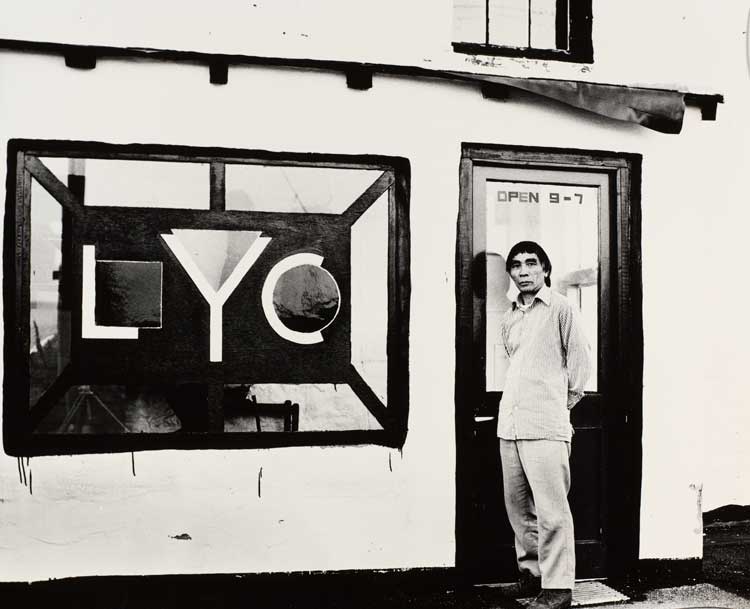
Li Yuan-chia standing at the porch of the LYC Museum and Art Gallery, featuring window designed by David Nash. Image courtesy of Li Yuan-chia
The present exhibition is organised playfully and flexibly with the same sort of openness and curiosity with which Li approached his various roles. It begins with his early work and his fascination for the cosmic point, a way of engaging with his interest in spirituality, technology and ecology. The range of works in this room is impressive, with everything from calligraphy and ink paintings to minimal works on paper, sculpture and installation. I was struck, too, by the assortment of materials he used, even for painting. Surfaces included linen, rice paper, fabric, wood and metal.
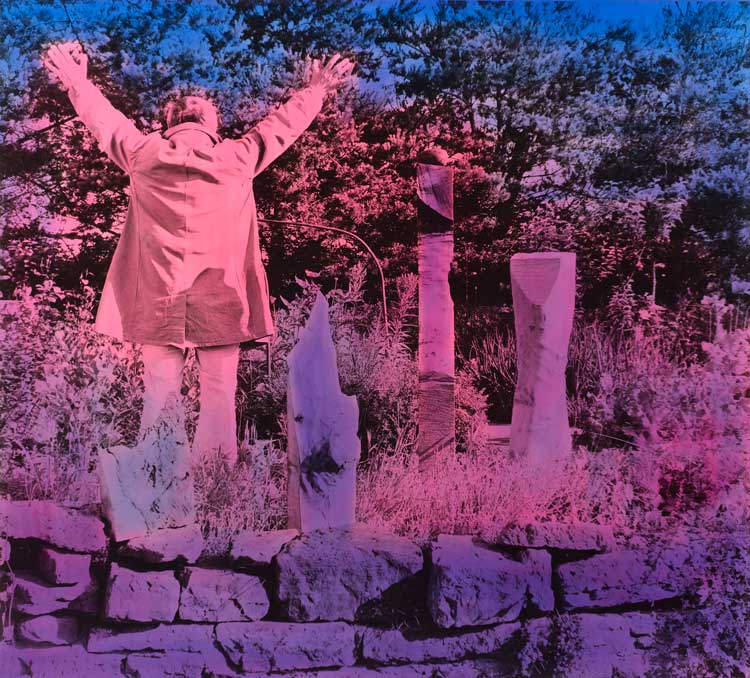
Li Yuan-chia, Untitled, 1994. Unique hand-coloured photographic print. Image courtesy of the Li Yuan-chia Foundation.
By way of context, Li’s work here is accompanied by that of other artists interested in cosmic or spiritual energies (there are echoes of Buddhism, Zen and Taoism). These include a work from Takis’s Signal Series from 1967, Liliane Lijn’s Cosmic Flares (1965-66), several works of concrete poetry by the Benedictine monk Dom Sylvester Houédard, and later paintings by Nicholson, including the quite astonishing work Consciousness (1980). It is wonderful to see these works together and recognise the resonances between them and their makers, especially when those associations emerge afresh and often just where we might least expect them.
The second space at Kettle’s Yard takes its cue from Li’s LYC motto – “Space | Time | Life” – and presents a veritable treasure trove of works that speak to ideas of home, belonging and nature. The focus here is on his time in Cumbria and his friends and visitors to the LYC, essentially a museum that included a children’s room, a performance space and a printing press, as well as a shared kitchen and garden, a library and displays of art. The shared ethos of space, time and life is explored through making in every conceivable material and form. Li worked in paint, photography, collage and other forms.
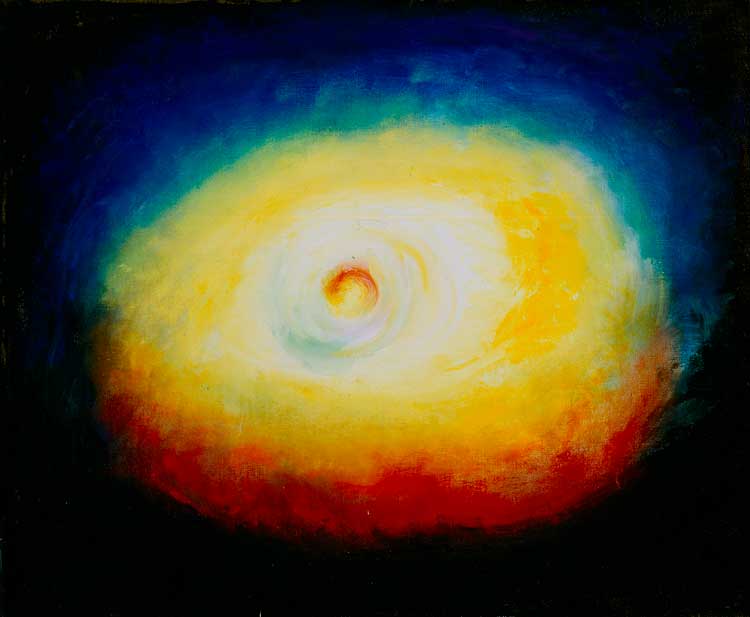
Winifred Nicholson, Consciousness, 1980. Oil on canvas, 62 x 75 cm. Private Collection. Image courtesy of Trustees of Winifred Nicholson.
Among his friends, there is Nicholson again, this time represented through paintings and also a circular rug she made in 1970 that certainly gestures to ideas of home and belonging. There is work by Lijn and Houédard once more, but lots more besides. Naum Gabo and David Nash have a significant presence here and there is something talismanic about Nash’s works such as LYC Sweepings (1982), Ladder (1978) and Twelve Hazel Ends (1977). It was Nash who made Window for the LYC (c1980), a work of stained glass in a wooden frame that acted as a signpost for Li’s museum and in this exhibition looks out on to Castle Street to welcome in visitors. Other works by Andy Goldsworthy used local materials, as in Hazel Stick Throws. Banks, Cumbria. 10 July 1980 (1980) and its counterpart, which documents the unused sticks from Goldsworthy’s morning’s work.
Upstairs in Kettle’s Yard’s research space, Making New Worlds shares archival films and materials from Li’s papers, lending further insight into his life and work. Here, and elsewhere around the exhibition, are also shown commissioned works by invited contemporary artists in response to Li and the LYC. Aaron Tan shows a multimedia sculptural work modelled on the LYC – Kitchen Cabinet (2022) – as well as Windows (2023), a mixed media installation with film projection. Both works by Tan speak to Li’s facility for hospitality. Grace Ndiritu made two Protest Carpets inspired by Li’s openness and interest in nature.
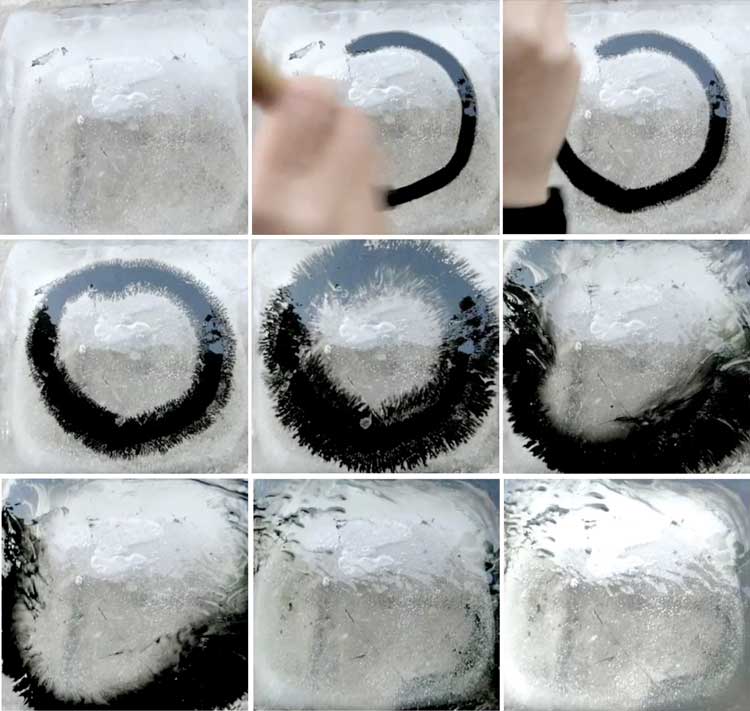
Charwei Tsai, Circle, 2009. HD colour video with sound, 40 sec. Image courtesy of Charwei Tsai.
Charwei Tsai has installed several series of offering bowls, designed to hold offerings and contribute to collective wellbeing at times of destruction and discontent. In this way, they invite participation and sharing among visitors and staff at Kettle’s Yard. Bettina Fung was commissioned to conduct a live drawing performance developed through research on Li and the LYC. Anna Brownsted’s Drawing Machine No 6 (2023), inspired by the drawing machine installed in the children’s room at the LYC, is a highlight of participatory excitement and seems to draw in people of all ages. A satellite exhibition at West Court Gallery, Jesus College, Cambridge focuses on Li’s calligraphy and works on paper showing his dedication to this practice throughout his long career.
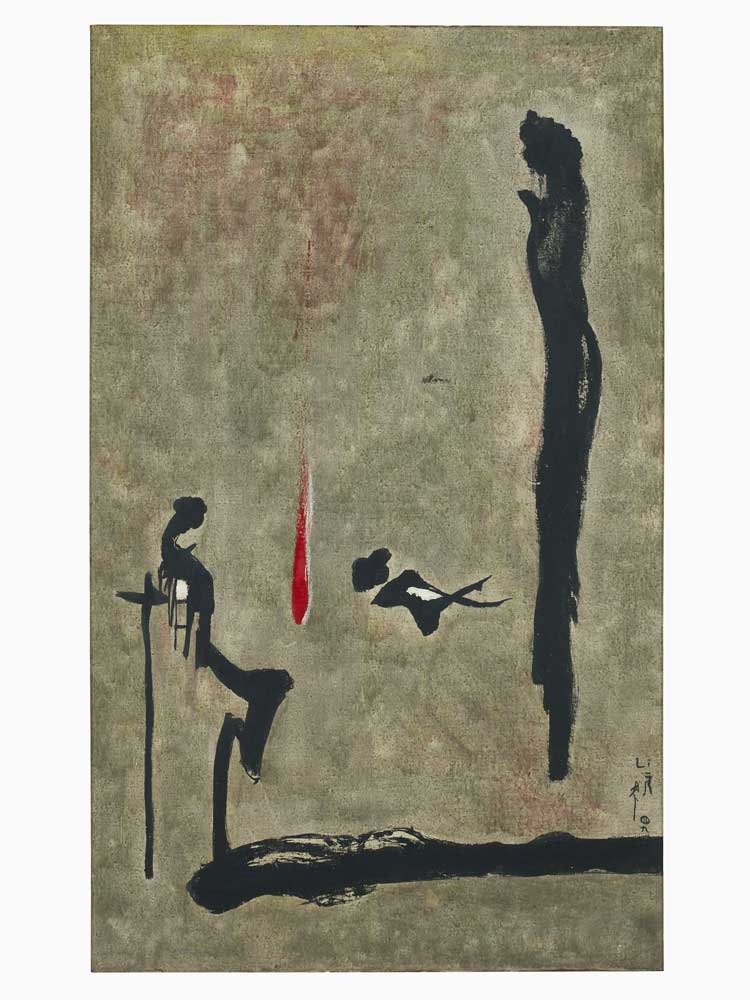
Li Yuan-chia, Untitled, c1960. Ink on paper. Image courtesy of the Li Yuan-chia Foundation.
With its three-strong curatorial team, half a dozen contemporary artists, eight or nine additional writers in the accompanying book, about 30 artists and hundreds of works on show, you would be right to say this exhibition is the result of a team effort, but most exhibitions are. What is different in this instance is a real sense of conviviality and friendship, being and making and working together in way that Li would have recognised, understood and valued. Our understanding of 20th-century British art is all the richer for it.
• The satellite exhibition Making New Forms: Li Yuan-chia and Friends is at West Court Gallery, Jesus College, Cambridge, until 18 February 20204.